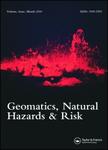版权所有:内蒙古大学图书馆 技术提供:维普资讯• 智图
内蒙古自治区呼和浩特市赛罕区大学西街235号 邮编: 010021

作者机构:Yunnan Univ Inst Int Rivers & Ecosecur Kunming Yunnan Peoples R China Yunnan Int Joint Lab China Laos Bangladesh Myanmar Kunming Yunnan Peoples R China Muhammad Nawaz Shareef Univ Agr Dept Agr Engn Multan Pakistan Univ Engn & Technol Ctr Excellence Water Resources Engn Lahore Pakistan Postdam Inst Climate Impact Res Leibniz Assoc Telegrafenberg Germany Univ Agr Dept Irrigat & Drainage Dera Ismail Khan Pakistan Czech Acad Sci Inst Comp Sci Prague Czech Republic
出 版 物:《GEOMATICS NATURAL HAZARDS & RISK》 (地球空间信息学、自然灾害与风险)
年 卷 期:2024年第15卷第1期
核心收录:
学科分类:07[理学] 0708[理学-地球物理学] 0815[工学-水利工程] 0706[理学-大气科学] 0816[工学-测绘科学与技术]
基 金:National Natural Science Foundation of China Surface Water Hydrology Project of the Water and Power Development Authority
主 题:Gilgit River basin general circulation model shared socioeconomic pathways UBC WM climate change runoff
摘 要:The inconsistent pattern of precipitation, a shift in the seasonality of river flows, and the early onset of snow and glacier melt in recent decades across river basins of High Mountain Asia (HMA) has compelled us to further investigate future variations in sources of runoff under projected climate change scenarios. This will help in determining the timing and magnitude of runoff components and this will help in management of future water resources. The current study employed the University of British Columbia Watershed Model (UBC WM) to estimate the spatiotemporal variations in simulated runoff components (i.e. snowmelt, glacier melt, rainfall-runoff, and baseflow) and their relative contribution to total runoff of Gilgit River regarding the baseline period (1981-2010) in near (2021-2050) and far future (2071-2100) under low (SSP1), medium (SSP2) and high (SSP5) emission scenarios. A significant increase in the magnitude of mean annual temperature and precipitation is expected in the near future (2021-2050) than far future (2071-2100) under most SSPs. Moreover, high-altitude stations of the Gilgit River basin are expected to experience more warming in the near and far future than low altitudes under all SSPs. On average, regarding the baseline period, the simulated runoff is projected to increase in the near (27%, 30%, and 33%) and far future (30%, 53%, and 91%) under SSP1, SSP2, and SSP5, respectively. Moreover, an early onset of snow/glacier melting is predicted in the far future due to an increase in summer air temperature and a decline in winter (DJF) precipitation. Besides, the rise in high altitude temperature is expected to cause the melting of snow/glaciers even above 6000 m elevation in the far future.